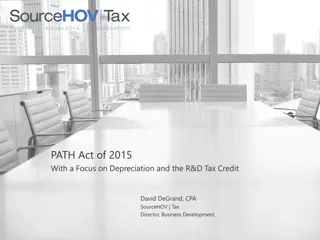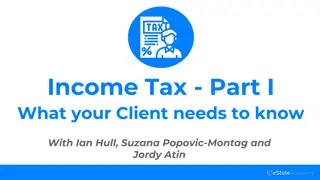Impact of 2018 Tax Act: Key Changes Explained
Explore how the new 2018 tax act impacts taxpayers, including changes to deductions, tax brackets, and the SALT deduction. Learn about the standard deduction increase, personal exemptions elimination, new tax brackets, and more insights from a CPA.
Download Presentation

Please find below an Image/Link to download the presentation.
The content on the website is provided AS IS for your information and personal use only. It may not be sold, licensed, or shared on other websites without obtaining consent from the author.If you encounter any issues during the download, it is possible that the publisher has removed the file from their server.
You are allowed to download the files provided on this website for personal or commercial use, subject to the condition that they are used lawfully. All files are the property of their respective owners.
The content on the website is provided AS IS for your information and personal use only. It may not be sold, licensed, or shared on other websites without obtaining consent from the author.
E N D
Presentation Transcript
IMPACT OF NEW 2018 TAX ACT By: David A. Widerman, CPA (CA License # 87106) California Perfect Tax E-mail- info@californiaperfect.tax Phone: (650) 590-9013
TABLE OF CONTENTS: 1. Why will only 6% of all taxpayers find it worthwhile to itemize? 2. What s happening to the SALT (state and local tax) deduction? 3. How do I take advantage of the new QBI deduction? 4. What tax deductions are disappearing? 5. Obamacare penalty (individual mandate) going away but when? 6. New 529 plan rules any child, any school. 7. Buying or improving a home? Be tax savvy. 8. Employee relocation? Moving expense surprise. 9. Why the rush to create a C-corporation? 10. Tax breaks for Parents 11. Elimination of Marriage Penalty 12. Changes in Alimony 13. Changes to Alternative Minimum Tax 14. Changes in Foreign Provisions
WHY WILL ONLY 6% OF TAXPAYERS FIND IT WORTHWHILE TO ITEMIZE?
STANDARD DEDUCTION AND PERSONAL EXEMPTION While it s being sold as a tax cut, the higher deduction really falls more under the category of a simplification. Yes, the standard deduction has roughly doubled for all filers, but the valuable personal exemption has been eliminated. For example, a single filer would have been entitled to a $6,500 standard deduction and a $4,150 personal exemption in 2018, for a total of $10,650 in income exclusions. Under the new tax plan, they would just get a $12,000 standard deduction. Is it better? But it s not really doubled. Having said that, here s a comparison between the standard deductions of the new and old tax laws.
THE 2018 TAX BRACKETS IN PRESIDENT TRUMP S CAMPAIGN TAX PLAN, HE PROPOSED REDUCING THE NUMBER OF TAX BRACKETS FROM SEVEN TO THREE, AND THE HOUSE OF REPRESENTATIVES ORIGINAL TAX REFORM BILL CONTAINED FOUR BRACKETS. HOWEVER, THE FINAL BILL KEPT THE SEVEN-BRACKET STRUCTURE BUT WITH MOSTLY LOWER TAX RATES. FOR COMPARISON, HERE ARE THE 2018 TAX BRACKETS THAT WERE SET TO TAKE EFFECT UNDER THE PREVIOUS TAX LAW.
WHATS HAPPENING TO THE SALT (STATE AND LOCAL TAX) DEDUCTION?
THE SALT DEDUCTION Perhaps the most controversial aspect of the tax reform on the individual side was the fate of the SALT deduction. Early versions of the bill proposed eliminating the deduction (which stands for state and local taxes ), which didn t sit well with some key Republicans in high-tax states. The final version of the bill keeps the deduction, but limits the total deductible amount to $10,000, including income, sales, and property taxes. No deduction for foreign property taxes.
HOW DO I TAKE ADVANTAGE OF THE NEW QBI DEDUCTION?
TAX CUTS AND JOBS ACT CHANGES UNDER TAX REFORM 2018 QUALIFIED BUSINESS INCOME DEDUCTION
GLOSSARY OF TERMS-FILING STATUS I. Single- Normally this status is for taxpayers who aren t married, or who are divorced or legally separated under state law IV. Head of Household- In most cases, this status applies to a taxpayer who is not married, but they are some special rules. For example, the taxpayer must have paid more than half the cost of keeping up a home for themselves and a qualifying person. Don t choose this status by mistake. Be sure to check all the rules. II. Married filing jointly- If taxpayers are married, they can file a joint tax return. If a spouse died in 2017, the widowed spouse can often file a joint return for that year. V. Qualifying Widow(er)- This status may apply to a taxpayer if their spouse died during 2016 or 2017. III. Married Filing Separately- A married couple can choose to file two separate tax returns. This may benefit them if it results in less tax owed than if they file a joint tax return. Taxpayers may want to prepare their taxes both ways before they choose. They can also use this status if each wants to be responsible only for their own taxes. VI. Qualifying Widow(er) with Dependent Child- This status may apply to a taxpayer if their spouse died during 2016 or 2017, and they have a dependent child. Other conditions may also apply.
GLOSSARY OF TERMS (CONT. ) Qualified Business (QB)- Any non C-corporate business other than a Specified Service Business ( SSB ). However, an SSB will qualify for the QBI deduction if the individual s taxable income is less than $207,500 (all taxpayers expect MFJ) or $415,000 for MFJ, for tax year 2018. Threshold is adjusted for inflation each year. Adjusted Gross Income (AGI) is defined as gross income minus adjustments to income. Refer to your most recent federal income tax return to get a quick estimate of your AGI. Specified Service Business- A specified service trade or business is any business involving the performance of services in the fields of health, law, accounting, actuarial, consulting, athletics, financial services, brokerage services, or any trade or business where the principal asset of such trade or business is the reputation or skill of one or more of its employees. Qualified Business Income (QBI)- The net amount of qualified items of income, gain, deduction, and loss with respect to any Qualified Business of the taxpayer. This does not include any qualified REIT dividends, qualified cooperative dividends, or qualified publicly traded partnership income. Unadjusted Basis of Property the depreciation period: Starts on date the property is placed in service and ends on the ends on the LATER OF: Taxable Income- Adjusted gross income minus any deductions or exemptions allowed in that tax year. Taxable income includes wages, salaries, bonuses, and tips, as well as investment income and unearned income. 10 years, or (5 year property, use 10 years) The last day of last full year in the asset s regular (Not ADS) depreciation period. (39 year property, use 39 years)
WHAT TAX DEDUCTIONS ARE DISAPPEARING?
While many deductions are remaining under the new tax law, there are several that didn t survive. Gone for the 2018 tax year are the deductions for: Casualty and theft losses (except those attributable to a federally declared disaster) DEDUCTIONS THAT ARE DISAPPEARING Unreimbursed employee expenses Tax preparation expenses Other miscellaneous deductions previously subject to the 2% AGI cap Moving expenses Employer-subsidized parking and transportation reimbursement
OBAMACARE PENALTY (INDIVIDUAL MANDATE) GOING AWAY BUT WHEN?
OBAMACARE PENALTIES WILL BE GOING AWAY Republicans were unsuccessful in their efforts to repeal the Affordable Care Act, otherwise known as Obamacare, in 2017. However, the tax reform bill repeals the individual mandate, meaning that people who don t buy health insurance will no longer have to pay a tax penalty. It s worth noting that this change doesn t go into effect until 2019, so for 2018, the Obamacare penalty can still be assessed.
NEW 529 PLAN RULESANY CHILD, ANY SCHOOL.
529 ACCOUNT FUNDS Under pre-Act law, funds in a Code Sec. 529 college savings account could only be used for qualified higher education expenses. If funds were withdrawn from the account for other purposes, the earnings portion of a nonqualified withdrawal was taxable as ordinary income and subject to a 10% additional tax unless an exception applied. Qualified higher education expenses included tuition, fees, books, supplies, and required equipment, as well as reasonable room and board if the student was enrolled at least half-time. Eligible schools included colleges, universities, vocational schools, or other postsecondary schools eligible to participate in a student aid program of the Department of Education. This included nearly all accredited public, nonprofit, and proprietary (for-profit) postsecondary institutions.
EXPANDED USE OF 529 ACCOUNT FUNDS New Law. One significant change is that the bill expands the available use of funds saved in a 529 college savings plan to include levels of education other than college. In other words (for distributions after Dec. 31, 2017), if you have children in private school, or you pay for tutoring for your child in the K-12 grade levels, you can use the money in your account for these expenses.
BUYING OR IMPROVING A HOME? BE TAX SAVVY The mortgage interest deduction can only be taken on mortgage debt of up to $750,000, down from $1 million currently. This only applies to mortgages taken after Dec. 15, 2017; pre-existing mortgages are grandfathered in. And the interest on home equity can no longer be deducted at all. Previously up to $100,000 in home equity debt could be deducted. New IRS requirement for mortgages on or before Dec.15,2017: 1. Binding mortgage contract on or before Dec. 15, 2017, and occupy home (move-in) by April 1, 2018.
EMPLOYEE RELOCATION? MOVING EXPENSE SURPRISE
EXCLUSION FOR MOVING EXPENSES FOR RELOCATING EMPLOYEES SUSPENDED UNDER PRE-ACT LAW NEW LAW For tax years beginning after Dec. 15, 2017, the exclusion for qualified moving expense reimbursements is suspended, except for members of the Armed Forces on active duty (and their spouses an dependents) who move pursuant to a military order and incident to a permanent change of station. Even worse the relocating employee cannot write off any moving expenses paid since the moving expense deduction has been repealed. Under pre-act law, a relocating employee could exclude moving expense reimbursements from his or her gross income and from his or her wages or employment tax purposes. These were any amount received (directly or indirectly) from an employer as payment for (or reimbursement of) expenses which would be deductible as moving expenses if directly paid or incurred by the employee.
WHY THE RUSH TO CREATE A C- CORPORATION?
CORPORATE TAX RATES So far we ve discussed individual tax reform, but the most dramatic changes made by the bill are on the corporate side. For starters, the bill lowers the corporate tax rate to a flat 21% on all profits. This is not only a massive tax cut, but it is a major simplification compared to the 2017 corporate tax structure. (see the table for rates under old law) The global average corporate tax rate is about 25%, so this move is designed to make the US more globally competitive, which should in turn help keep more corporate profits (and jobs) in the US. In addition to these changes, the corporate Alternative Minimum Tax of 20% has been repealed.
TAX BREAKS FOR PARENTS The new 2018 tax law increases the Child Tax Credit, which is available for qualified children under the age of 17. Specifically, the bill doubles the credit from $1,000 to $2,000, and also increases the amount of the credit that is refundable to $1,400. In addition, the phaseout threshold is dramatically increasing.
TAX BREAKS FOR PARENTS CONT. If your children are 17 or older or you take care of elderly relatives, you can claim a $500 credit, subject to the same income thresholds. Furthermore, the Child and Dependent Care Credit, which allows parents to deduct qualified child care expenses, has been kept in place. This can be worth as much as $1,050 for one child under 13 or $2,100 for two children. Plus, up to $5,000 of income can still be sheltered in a dependent care flexible spending account on a pre-tax basis to help make child care more affordable. You can t use both of these breaks to cover the same child care costs, but with the annual cost of child care well over $20,000 per year for two children in many areas, it s safe to say that many parents can take advantage of the Flexible Spending Account and Credit, both of which remain in place.
ELIMINATION OF MARRIAGE PENALTY One thing to notice from these brackets is that the so-called marriage penalty, which many Republican leaders (including President Trump) wanted to eliminate, is almost absent.
HOW DOES THE MARRIAGE PENALTY WORK? If you re not familiar, here s a simplified version of how the marriage penalty works. Let s say that two single individuals each earned a taxable income of $90,000 per year. Under the old 2018 tax brackets, both of these individuals would fall into the 25% brackets for singles. However, if they were to get married, their combined income of $180,000 would catapult them into the 28% bracket. Under the new brackets, they would fall into the 24% marginal tax bracket, regardless of whether they got married or not. In fact, the married filing jointly income thresholds are exactly double the single thresholds for all but the two highest tax brackets in the new tax law. In other words, the marriage penalty has been effectively eliminated for anyone except married couples earning more than $400,000.
Under pre-Act law, alimony and separate maintenance payments were deductible by the payor spouse and includable in the income of the payee spouse. New Law. For any divorce or separation agreement executed after Dec. 31, 2018, alimony and separate maintenance payments are not deductible by the payor spouse and are not included in the income of the payee spouse. ALIMONY DEDUCTION BY PAYOR/INCLUSION BY PAYEE SUSPENDED
CHANGES TO ALTERNATIVE MINIMUM TAX
ALTERNATIVE MINIMUM TAX 2.0 The alternative minimum tax (AMT) was implemented to ensure that high-income Americans paid their fair share of taxes, regardless of how many deductions they could claim. Essentially, higher-income households need to calculate their taxes twice once under the standard tax system and once under the AMT and pay whichever is higher. The problem is that the AMT exemptions were not initially indexed for inflation, so over time, the AMT started to apply to more and more people, including the middle class, which it was never intended to affect. In addition, the income thresholds at which the exemption amounts begin to phase out are dramatically increased. Currently, these are set at $160,900 for joint filers and $120,700 for individual filers, but the new law raises these to $1 million and $500,000, respectively. So, the tax reform bill permanently adjusts the AMT exemption amounts for inflation in order to address this problem, and makes them significantly higher initially in 2018. Here s how the AMT exemptions are changing for 2018
CHANGES IN FOREIGN PROVISIONS
CHANGES IN FOREIGN PROVISIONS A territorial tax system Repatriation of foreign cash and assets The tax reform bill also changes the US corporate tax system from a worldwide one to a territorial system. Currently, US corporations have to pay the US taxes on their profits earned abroad, and the new system will end this effective double-taxing of foreign profits. As a result of the worldwide tax system, which makes foreign profits subject to the 35% top corporate tax rate, there is about $2.6 trillion in US corporations foreign profits held overseas. In order to bring this money back to the US, the new tax law sets a one-time repatriation rate of 15.5% on cash and equivalent foreign-held assets and 8% on illiquid assets like equipment, payable over an 8 year period. This could be big news for companies like Apple, which has more than $200 billion parked overseas.



![Town of [Town Name] Real Estate Tax Rates and FY 2024 Budget Summary](/thumb/62211/town-of-town-name-real-estate-tax-rates-and-fy-2024-budget-summary.jpg)








